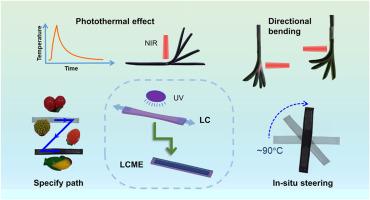Multi-stimulus responsive soft actuator with thermotropic shape memory and local magnetic programming properties
IF 14.2
1区 材料科学
Q1 ENGINEERING, MULTIDISCIPLINARY
引用次数: 0
Abstract
Soft materials possess the ability to deform or change shape when subjected to external stimuli, which makes them commonly used in the field of soft actuators. Under the actuation of single excitation such as light, heat, electricity, or magnetism, the deformation or motion mode of most soft actuators is monotonous. To achieve a multi-stimulus responsive actuation mode, the soft composite material LCE-CNT/MRF/Ecoflex (LCME) is developed by assembling liquid crystal elastomer (LCE) containing carbon nanotubes (CNTs), magnetorheological fluid (MRF) and Ecoflex. Among them, the additive-free high-performance MRF is prepared by mixing ionic liquid and silicone oil as carrier liquid, and provides magnetic actuation characteristic for LCME. The LCE is a mesh structure material formed by embedding mesogens into elastic polymers and moderate cross-linking them, possessing both soft elasticity and thermotropic shape memory properties. Assisted by the photothermal effect of CNTs, the rising temperature induces the rearrangement of mesogens in LCE containing CNTs (LC), allowing the LC to achieve reversible bidirectional deformation between an initial configuration and a thermotropic configuration. Under the multi-excitation actuation of photothermal effect and magnetic field, the LCME can perform bidirectional crawling and in-situ steering on a plane. This work demonstrates that multi-excitation actuation is beneficial in enriching the motion modes of soft actuators and points out a potentially promising direction for the development of soft robots.

具有热致形状记忆和局部磁规划特性的多刺激响应软驱动器
软材料在受到外界刺激时具有变形或改变形状的能力,这使得它们在软执行器领域中得到了广泛的应用。在光、热、电、磁等单一激励的驱动下,大多数软执行器的变形或运动方式是单调的。为了实现多刺激响应驱动模式,将含有碳纳米管(CNTs)、磁流变液(MRF)和Ecoflex的液晶弹性体(LCE)组装在一起,开发了LCE- cnt /MRF/Ecoflex (LCME)软复合材料。其中,以离子液体和硅油为载液混合制备了无添加剂高性能磁流变液,并为LCME提供磁致动特性。LCE是一种通过在弹性聚合物中嵌入介质并适度交联而形成的网状结构材料,具有软弹性和热致形状记忆性能。在CNTs的光热效应的辅助下,温度升高诱导含CNTs的LCE (LC)中介质重排,使LC在初始构型和热致性构型之间实现可逆的双向变形。在光热效应和磁场的多重激励下,LCME可以在平面上进行双向爬行和原位转向。研究表明,多激励驱动有助于丰富软机器人的运动模式,为软机器人的发展指明了一个有潜力的方向。
本文章由计算机程序翻译,如有差异,请以英文原文为准。
求助全文
约1分钟内获得全文
求助全文
来源期刊

Composites Part B: Engineering
工程技术-材料科学:复合
CiteScore
24.40
自引率
11.50%
发文量
784
审稿时长
21 days
期刊介绍:
Composites Part B: Engineering is a journal that publishes impactful research of high quality on composite materials. This research is supported by fundamental mechanics and materials science and engineering approaches. The targeted research can cover a wide range of length scales, ranging from nano to micro and meso, and even to the full product and structure level. The journal specifically focuses on engineering applications that involve high performance composites. These applications can range from low volume and high cost to high volume and low cost composite development.
The main goal of the journal is to provide a platform for the prompt publication of original and high quality research. The emphasis is on design, development, modeling, validation, and manufacturing of engineering details and concepts. The journal welcomes both basic research papers and proposals for review articles. Authors are encouraged to address challenges across various application areas. These areas include, but are not limited to, aerospace, automotive, and other surface transportation. The journal also covers energy-related applications, with a focus on renewable energy. Other application areas include infrastructure, off-shore and maritime projects, health care technology, and recreational products.
 求助内容:
求助内容: 应助结果提醒方式:
应助结果提醒方式:


